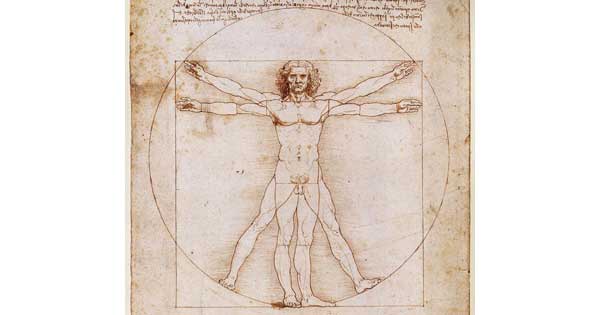
Da Vinci’s Ghost: Genius, Obsession, and How Leonardo Created the World in His Own Image, By Toby Lester, Free Press, 275 pp., $26.99
Although the term “Vitruvian Man” first appeared in print in 1500, it lingered in obscurity until the worldwide phenomenon of Dan Brown’s potboiler The Da Vinci Code (2003), in which the first murder victim is found spread-eagled and naked like the subject of Leonardo’s drawing of ideal human proportions, preserved in the Venetian Gallerie dell’Accademia. For evident reasons of marketing, the title of Toby Lester’s Da Vinci’s Ghost persists in Brown’s error of mistaking Leonardo’s place of origin for his surname (he didn’t have one), and Lester, like Brown, has a knack for deploying information in a way that keeps his readers hooked. But the resemblances end there. Lester’s Leonardo is a real person, Lester himself is a real writer, and the story he has to tell is true. This is an enthralling book about a famous drawing and its equally famous creator, who becomes disarmingly, even heartbreakingly human in the author’s sympathetic hands.
We are accustomed to thinking of Leonardo as a towering genius with long white hair, a long white beard, and an intent expression; who would ever have connected him with the wiry young dandy who posed for Andrea del Verrocchio’s bronze David c. 1466? But of course Leonardo was young once, and was more likely than not a taut little Etruscan rather than an imposing giant. (And it should be noted that Lester has taken his cue, as he makes clear, from Charles Nicholl’s Leonardo da Vinci: Flights of the Mind of 2004—the perfect book to read along with Da Vinci’s Ghost.) Lester traces him from tiny Vinci to Verrocchio’s Florentine workshop, where the young apprentice pens a poignant note in his famous left-handed script to say, “I am happy.” That happiness was only a temporary condition: Lester outlines all the insecurities that necessarily attacked a person as unusual as Leonardo, whose talent could not quite compensate for the social disadvantages posed by his spotty education, uncertain income, illegitimate birth, and aversion to marriage (how could someone with his social and economic limitations have married even if he had wanted to?). And so, in many ways, Leonardo created his own world at the same time that he turned his gimlet eye on the one around him.
Lester re-creates both Leonardo’s outer and inner worlds, providing telling glimpses into the lives of several other strangely elusive figures along the way: the ancient Roman architect Vitruvius, who appears between the lines of his Ten Books on Architecture as a gentleman poised somewhere between his practical career as an architect (he manned catapults for Julius Caesar and built a wooden basilica for the Roman colony of Fanum Fortunae, modern Fano) and his literary aspirations. For reasons that are still a matter of intense debate among scholars and architects, Vitruvius wrote the only treatise on architecture to survive through the Middle Ages into the Renaissance, where it came to the attention of a Florentine as strangely displaced as Leonardo, Leon Battista Alberti (another illegitimate child, and an exile for much of his life), who complained that Vitruvius might as well never have written at all, because he was so hard to understand. So Alberti wrote his own updated Ten Books on Architecture, De Re Aedificatoria, c. 1450, while performing bureaucratic tasks for Pope Nicholas V and trying out his own architectural designs, one of which may be the basin of the Trevi Fountain. His first major commission, appropriately enough, was in Rimini, right up the road from Fano, where he built the spectacular Malatesta Temple for the devilishly handsome warlord Sigismondo Pandolfo Malatesta.
 Like Alberti, Leonardo also eventually sought out a place in the entourage of a warlord, Ludovico Sforza, who, like Sigismondo Malatesta in Rimini, assembled a coterie of artists, musicians, and scholars along with his mercenary troops, his young wife, and his mistresses. Ludovico’s favorite mistress, Cecilia Gallerani, was beautiful, at least if we are to believe Leonardo’s portrait of her holding an ermine. In those days she was also a teenaged brat who hit people as a way of expressing her pique, but she apparently aged gracefully and became a woman well worth knowing. Leonardo kept her as a friend for life. Milan also brought him into the company of the painter, architect, and musician Donato Bramante and the Sienese engineer Francesco di Giorgio Martini, to whom Lester introduces us at the very beginning of his book. With these friends came new ideas, including what may have been Leonardo’s first encounter with Vitruvius. The Ten Books were indeed written in difficult Latin, but Leonardo drilled himself in the ancient language until he could begin to understand what Vitruvius wrote (and he had the help of Bramante and di Giorgio, though they, too, were trained as craftsmen rather than scholars).
Like Alberti, Leonardo also eventually sought out a place in the entourage of a warlord, Ludovico Sforza, who, like Sigismondo Malatesta in Rimini, assembled a coterie of artists, musicians, and scholars along with his mercenary troops, his young wife, and his mistresses. Ludovico’s favorite mistress, Cecilia Gallerani, was beautiful, at least if we are to believe Leonardo’s portrait of her holding an ermine. In those days she was also a teenaged brat who hit people as a way of expressing her pique, but she apparently aged gracefully and became a woman well worth knowing. Leonardo kept her as a friend for life. Milan also brought him into the company of the painter, architect, and musician Donato Bramante and the Sienese engineer Francesco di Giorgio Martini, to whom Lester introduces us at the very beginning of his book. With these friends came new ideas, including what may have been Leonardo’s first encounter with Vitruvius. The Ten Books were indeed written in difficult Latin, but Leonardo drilled himself in the ancient language until he could begin to understand what Vitruvius wrote (and he had the help of Bramante and di Giorgio, though they, too, were trained as craftsmen rather than scholars).
The guiding theme of the Ten Books struck a deep chord in Leonardo, for he, like Vitruvius, believed that beneath the incredible variety of the natural world a thinking person could discern a whole system of harmonious proportions. According to Vitruvius, “the power of nature has acted as architect” to create the music of the spheres, and to shape people, plants, animals, and landscapes and move souls by the sheer power of beauty. Leonardo, as Lester notes, examined the inside of real human skulls in an effort to pinpoint the location of the soul, but he also examined the human body to discern its ideal proportions. Vitruvius declared in the third of his Ten Books that one sign of a body’s perfection was the fact that it could be inscribed perfectly into both a circle and a square, and this is what Leonardo eventually tried to do on paper with his Vitruvian Man, perhaps around 1490. There are several distinctive aspects of his creation. In the first place, the circle and square that circumscribe him share the ground line on which he stands, but they are not inscribed within each other. If the two abstract geometric figures were nested one within the other, the proportions of the man inside them would be grotesque, as the Milanese architect Cesare Cesariano proved when he illustrated his translation of Vitruvius in 1521 with men inscribed within squares inscribed within circles. Thanks to this shared ground line (an idea Leonardo probably got from an illustrated 15th-century copy of Vitruvius drafted by Giacomo Andrea da Ferrara), Leonardo’s man is beautifully proportioned. He turns out one leg to provide a perfectly profiled foot, which is another Vitruvian unit of measure. At last, Toby Lester asks us to look once again at the face of this drawn man, who embodies the harmonies of the universe in his physical form, but also, one has come to suspect, in the recesses of his soul. Our guide has led us very carefully to this moment, when we peer once again, really looking this time, into the Vitruvian Man’s stern, remarkable face, and the eyes tell us what we have begun to suspect already. Photographs of Picasso have the same expression—the same eyes drilling us with their intensity. Of course the Vitruvian Man is Leonardo; we can see his similarities both to Verrocchio’s David and to the old man we know, the sage he shall become. But thanks to Lester’s marvelous characterization, we have an entirely different understanding, by this time, of who and what kind of man Leonardo is. The author himself writes that in looking at the Vitruvian Man, he has the sense that he is looking at Leonardo’s ghost. But he has drawn his own picture so vividly that when his readers look at the drawing, we see not Leonardo’s ghost, but Leonardo himself, alive and real, and immortal.

